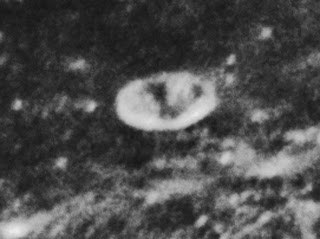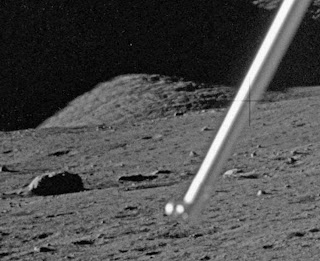Here's a long excerpt from pp. 160-165 of
Ancient Aliens on the Moon. It's from Chapter 7, which is all about the Apollo 17 mission to Taurus-Littrow.
================================================
"At first, AS17-134-20391doesn't seem very interesting or controversial. A hand-held Hasselblad shot taken by astronaut Gene Cernan, it shows the view out of the moving Lunar Rover as the astronauts made their way to geology station 1. The mountains in the background are Bear Mountain and part of the East Massif. Again, this all appears fairly unremarkable until you zoom up close onto the base of the East Massif and see... condos.
caption: High contrast enhancement of AS17-134-20391
[...5 paras elided...]
Further proof in support of this model (and the lunar dome model) came in the form of images scanned and downloaded from an Italian web site (since extinct) that displayed high resolution scans of photos taken on EVA-1 at around the same time and location. Apparently procured from European versions of early generation NASA negatives, these photos painted a completely different picture of the Taurus-Littrow valley than the one NASA has sought to advance for years.
Taken by Jack Schmitt a few minutes after Cernan's earlier photo of the East Massif and Mons Vitruvius, ... Schmitt's photo AS17-136-20767 also shows something else; a piece of semi-transparent spar-like glass structure which has sagged and collapsed over the mountain.
caption: AS17-136-20767 and the Spar
I must make it very clear here, this obviously structural spar does not appear currently on any NASA versions of this frame. It appears only on the Italian version apparently procured from a European scientific archive. Because of this, some people have sought to downplay it as a scratch on the print or negative, but this can be discounted by several observations. First, if you notice the spar follows the geometry of the light on the Moon that day; brighter and more reflective in the areas where there is ample sunlight and nearly invisible in the darker shadowed areas of the photo. It also follows the contours of the East Massif itself and seems to be anchored to the ground by a thin connecting wire. "Scratches" simply do not follow the contours of terrain or the geometry of the lighting in a photograph. If it was a scratch and not actually on the surface of the Moon, it would be the same brightness along its entire length.
There is also the question of the photo itself, which is of much higher quality than many NASA scans available today. This is because most of the photos on official NASA sites are copies of copies of copies, many generations removed from the originals. These Italian images appear to be more akin to Ken Johnston's first generation prints in quality and detail. This makes the "scratch" explanation even more unlikely."
========================================
I'll leave you to figure out what exactly "the geometry of the light" means. It seems to me that there's more than adequate sunlight to illuminate the whole of a spar, if it existed. Anyway, I decided to investigate, and discovered that, although the Italian web site seems moribund, it is not actually extinct. If you google the string 'AS17-136-20767' and ask Mr. Google to show you only Italian hits, you get led
here and
here.
Mike Bara's contention that this image is of superior quality to the "official" NASA versions of the shot is immediately belied. IT IS NOT TRUE that the NASA imagery is "copies of copies of copies, many generations removed from the originals." The historians who compiled the Apollo image libraries had access to very early generation material. In fact, The official Apollo 17 image library offers this image in two sizes:
248K and high-res
1217K. Check 'em out--if they are inferior to the Italian image I'll never eat
penne all'arrabbiata again.
A little more digging produced the name of the Italian astronomer who made that long list of "anomalous" Apollo imagery. His name is Davide De Martin, and he's
a good-looking guy who actually works professionally as an image processor for the European Hubble office. I contacted Signor De Martin. I wanted to know whether he also had on file the images "on either side" of AS17-136-20767--namely,
AS17-136-20766 and
AS17-136-20768. Since the set was part of a left-to-right panning sequence, the same part of East Massif was captured in those frames and so, obviously, the "spar" would appear in those too, if it was real. De Martin graciously replied as follows:
"That's not a spar, obviously, but just an artifact likely due to the
scanning process or whatever. No trace of the artifact in 20766 and
20768 which show the same hill."
Even more helpful, he attached to his message his actual scans of AS17-136-20766 and AS17-136-20768, so I could verify for myself that the spar was not to be seen. Here's his scan of 20768:
So once again Mike Bara has given his fans totally false information. The "obviously structural spar" is in fact an "obvious scanning error." Will he ever apologize? I really doubt it.
Update:
Chris, a regular reader of this blog, now claims to have incontrovertible photographic evidence that there really is a spar at Taurus-Littrow.
Can't argue with that....











